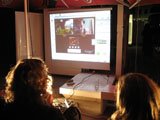Metadata by everybody
Dear Ursula,thanks so much for your remarks and thoughts about the terminological struggles surrounding media art, netart, digital art, digital culture, networked art...(ok, I'll stop here ;-)
I especially appreciated your remark about Rhizome's ArtBase, which allows people to create an individual terminology for their respective artworks.
This brings me to a related article I currently read in the Infotangle blog:
Ellyssa Kroski writes about the "Hive Mind: Folksonomies and user-based tagging." In this article she examines users, who "are adding metadata and using tags to organize their own digital collections, categorize the content of others and build bottom-up classification systems." She has found an interesting conclusion for the evolving folksonomy platforms worldwide, I quote: "Metadata is now the realm of the everyman."
I think this observation is worthwile to place against the backdrop of the shifting roles of curators. Given the fact, that art institutions increasingly have to deal with digital or other types of intangible or ephemeral artworks these days, we can already witness a change of paradigms from the object towards the process surrounding an object. Furthermore, there are growing numbers of artworks which invite their audience to interact with them, edit them or even add new contents to them.
This development poses a fresh set of challenges to curators and apparently it triggers an additional, new notion of curatorial work, which I would describe as "enabling feedback processes". Does that make sense? I am especially refering to new initiatives such as the tagging prototype tests led by the ">Metropolitan Museum of Art: They invited their online audience to provide keywords and tags for their art collection. The New York Times reports of "staggering results" and quotes Susan Chun, general manager for collections information planning at the Met. “There’s a huge semantic gap between museums and the public.” The Archives and Museums Informatics Group supports initiatives like that and points out that contents are often hidden away from nonspecialists. “We’ve got to provide access on the same level as visual memory.” says Jennifer Trant, a partner at Archives and Museum Informatics in Toronto.
There is apparently a growing number of museums which start to rethink their online collections. Have you heard for example of the steve.museum tagging project? They call their project "the first experiment in social tagging of art museum collections." I was really striked when I read about their endeavour. The participants of this project (= everybody who is interested) are "building a tagging tool, collecting tags, analyzing data, and engaging in discussion." Their overall aim is to find new ways of improving access to works of art. Wow, I think this is quite an interesting approach.
Well, but it's not only the collections which tend to involve user-generated contents, tags and taxonomies. There is also a new trend to publish books as open-source wiki books, which invite everybody to add and comment on them. As an example, I want to mention the book "New Media Art" by Mike Tribe and Reena Jana. This Wiki book is published under the "Attribution-Noncommercial-Sharealike 2.5" Creative Commons License.
I think this is an extraordinary interesting development. In my opinion, that's exactly what Manuel Castells describes as a process which "shapes culture and gets shaped by it at the same time."
And, last but not least, your latest work, the HTML-butoh fits perfectly in this framework. It encourages a worldwide audience to submit their visual vocabulary of the HTML-language. This user-generated library is actually the basis of the artwork. It would be great, by the way, if you could tell us a bit about the reactions of your audience to this project.
So, that was it from Berlin for today.
We will have an Upgrade! field trip later that day and visit the NewYorkRioTokyo gallery.
All the best,
Ela


0 Comments:
Post a Comment
<< Home